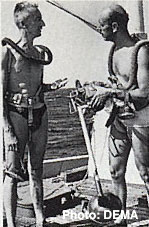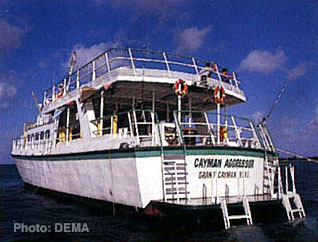


To meet this demand, various attempts were made at outfitting converted fishing and shrimp boats with compressors, bunks and basic food service. Showers were almost nonexistent and toilet facilities were primitive at best.

These early vessels filled a certain niche in the diving community and catered to the hard-core gorilla diver. These divers would forsake the conveniences of home for the opportunity to dive four or five times a day on little explored reefs.
By the early 1970's the term "live-aboard" became better defined as diving became a more popular sport and expectations of this more upscale clientele demanded more than good diving, a bunk and PB&J sandwiches.
One of the first successful live-aboards was an old 70-foot commercial boat that Bob Soto of Grand Cayman converted into the Cayman Diver. Soto sold the boat to Paul Humann who made it into a success by offering unlimited diving over some of the Caribbean's finest sites while providing semiprivate rooms and quality food.
Bret Gilliam's 85-foot Virgin Diver followed in 1976. The Virgin Diver was based in the Virgin Islands and was a converted private yacht. The addition of central air conditioning, private cabins and a bona fide chef set the stage for rapid growth in the live-aboard industry.
In the early 1980's, the stabilization of world oil markets left a glut of aluminum crew boats which had served in the oil fields of the Gulf of Mexico. This fact, combined with the foresight of dive entrepreneur Wayne Hasson and shipyard owner Paul Haines sparked a new drive to refit these aluminum workboats into comfortable, functional live-aboards. Thus was the beginning of the Aggressor fleet.
In 1984 the Cayman Aggressor was launched and became an instant success. The next year saw the introduction of the Cayman Aggressor II . By 1994 the Aggressor fleet was composed of nine vessels, five in the Pacific and four in the Caribbean. The modern live-aboard fleet was born.

The Aggressor Fleet was the first and fastest owing to its franchised ownership of different vessels by different individuals and companies and to the ability of its shipyard operation to quickly convert existing oil field crew boats. Another Company led by dive entrepreneur Peter Hughes quickly followed with a similar fleet of converted crew vessels all under one Corporate ownership. The Peter Hughes Fleet has aimed for high consistency and quality standards throughout its world wide operations enforced by singular corporate ownership. Many other fleet operations exist ranging from the Blackbeard fleet of four sailing vessels based in Miami, Florida and Nassau, Bahamas to the Law vessels of British Virgin Islands and Galapagos and the Peace Fleet of California. Individual vessels abound including the Sol Mar of Mexico and the Nekton Pilot SWATH vessel of the Bahamas.
With the growth of the dedicated Live-aboard vessels, interest in the dive market has been ignited in the world of pseudo-live-aboards like Windjammer barefoot cruises and even more remotely, the large cruise vessels of Carnival, Royal Caribbean and Princess Cruises.
The growth of the modern live-aboard fleet has been the single largest segment of dive travel in the last ten years. What had once been the domain of the hard-core guerilla divers was now catering to families, grandparents, and newly certified divers. Modern live-aboards now provide accommodations and amenities equal to, if not surpassing, that of many land-based resorts. The modern live-aboard is now the symbol for active divers and there traveling companions who want to maximize bottom time without sacrificing creature comforts.
Source:
Academy of Liveaboard Diving
Academy of Liveaboard Diving



All
contents of this site © 2005 Milly Armao, except where
otherwise noted.